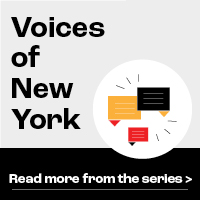
Fernando Martínez / Impremedia
Parents and advocates rallied last week calling for a cultural expansion plan for NYC schools.This article was originally reported and published by El Diario on May 19, 2021. It was translated by Carlos Rodriguez and has been updated and lightly edited for clarity.
Last week, a group of organizations demanding a more culturally diverse curriculum in New York City public schools took to the Department of Education’s (DOE) Lower Manhattan headquarters seeking to remind the authorities of the debt they have with the city to expand culturally responsive projects in schools.
According to activists from the NYC Coalition for Educational Justice (CEJ,) the DOE has committed to investing in a revision of its public school curriculum, as well as purchasing or creating new textbooks that allow students from immigrant communities, particularly those of color, to have access to more diverse authors, books and themes.
In a press release, the CEJ said that the city’s budget will contain an “unprecedented” amount of money in the next fiscal year.
“Now that they have the funding to do right by the 1.1 million children currently in public schools, they are choosing to continue using racist, inaccurate and obsolete curricula with our children,” they stated.
The organization’s leaders said that New York City’s public education system will have more than $12 billion in its coffers in the coming fiscal year, of which, so far, no amount has been assigned toward making changes to the curriculum to make it more culturally inclusive.
“The mayor’s executive budget is not conducive to culturally responsive education. We are calling on parents and representatives to join this petition. In a city like ours, it makes no sense for classroom instruction not to be more comprehensive,” said Guatemalan-born Kevin Duarte, from Masa, a non-profit dedicated to promoting changes in school curricula in the South Bronx.
A CEJ report found that while only 15 percent of all public school students in New York City are white, on average, 84 percent of the authors taught in elementary schools are white.
The complaints also reveal that white authors and fictional characters also dominate the book lists most commonly used in city schools.
“It is crucial to see oneself represented and reflected in the books, in the stories, in order to build a model of tolerance, to teach that there are people with different experiences, particularly among communities defined by migration,” said Duarte.
Emira Campos, a 28-year-old Ecuadoran mother, said that her daughter, who is in first grade at a Queens public school, only has access to stories that offer her a “limited worldview.”
“Obviously, there is the job that we as parents have of transmitting our culture to her, our people’s history, but we would just like the model to be a bit broader. It would even be to the benefit and further development of the city,” said Campos.
Plácida Rodríguez, a Dominican grandmother of two public school students and a member of non-profit Make the Road NY (MRNY) said the campaign ultimately aims to improve the quality of education.
“New York is a city of immigrants. It is very important that a curriculum is adopted which reflects our Hispanic culture, as well as the African-American one, the cultures of our ancestors. This is about fighting for a more expanded system that provides our students with a different view of the world,” she said.
Before the pandemic, former Schools Chancellor Richard Carranza expressed his support for more diverse booklists.
To the demands made by these organizations of parents and representatives, DOE spokeswoman Danielle Filson responded that the city has already reserved $23 million to fund anti-bias training for school staff.
“Our students need to see themselves in the books they read and in the lessons they are taught. We are prioritizing creating a culturally responsive curriculum that includes a wide range of voices,” she said.
The CEJ acknowledges that funding has been invested in anti-bias training for DOE staff in the last few years. However, they say that there is an outstanding “debt” in the form of revised booklists and more inclusive teaching.
“The Department of Education has made it clear that an inclusive and high-quality curriculum is key to our recovery, and we will continue to partner up with our communities, students, families and educators to deepen our progress,” a DOE source told El Diario.









One thought on “Immigrant Parents Press DOE for Culturally Responsive Curriculum in Schools”
How the hell are these people going to complaint about anything hell their children weren’t even in school before they came to our country dam that makes me angry people from other countries coming to our country demanding shit take your stupid asses back to your countries and demand things from your leaders